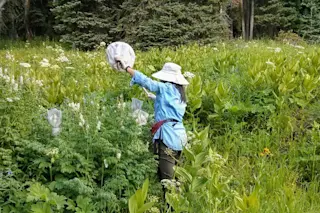A bumblebee “robs” from a flower, extracting the plant’s nectar without providing any pollination.Christopher Wren
We weave along a path beaten between Rocky Mountain wildflowers that bloom and bobble over our heads, chasing the elusive Orange 78.
She disappears into a cloud of white Sierra fumewort flowers. Then Yellow 54 sails into view and we rush to follow, angling through the surrounding green curtains to keep up. She makes a beeline for the Mertensia ciliate, or mountain bluebell. And it truly is a beeline — Yellow 54 is a bumblebee with a yellow dot and number superglued to her back. She was trapped, tagged, registered and DNA-sampled a few days earlier for research purposes.
Ecology undergraduate researcher Karen Wang drops her fine-mesh bee net, whips out a small recorder and leans in to observe Yellow 54 climbing into the bluebell’s long tubular blooms. “One,” she says of the bee’s quick ...















